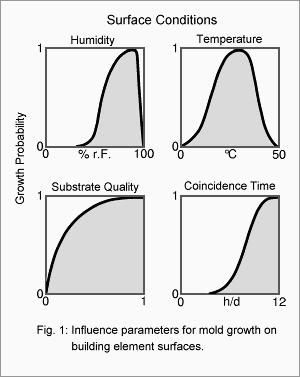 Under unfavorable ambient conditions, microbial growth may occur on the surfaces of building components. The most important factors are temperature, relative humidity, a substrate with sufficient nutrients and the daily duration of the period where all growth conditions prevail simultaneously (coincidence time). While bacteria need relative humidities of at least 90% for being able to grow, certain xerophilic fungi can thrive at humidities as low as 65%, and most fungi can cope with humidities as low as 80%. Mold fungi also tolerate a larger temperature bandwidth than other organisms, they may grow between 0°C and 50°C. Therefore the whole range of humidities and temperatures mentioned above may be considered to pose a potential mold growth risk.
Under unfavorable ambient conditions, microbial growth may occur on the surfaces of building components. The most important factors are temperature, relative humidity, a substrate with sufficient nutrients and the daily duration of the period where all growth conditions prevail simultaneously (coincidence time). While bacteria need relative humidities of at least 90% for being able to grow, certain xerophilic fungi can thrive at humidities as low as 65%, and most fungi can cope with humidities as low as 80%. Mold fungi also tolerate a larger temperature bandwidth than other organisms, they may grow between 0°C and 50°C. Therefore the whole range of humidities and temperatures mentioned above may be considered to pose a potential mold growth risk.
Fig. 1 shows a qualitative assessment of the growth conditions for mold in dependence of the above factors. These functional relationships served as the basis for a prediction method for assessing the mold growth risk which has already been applied repeatedly and has been validated by comparison with experiment [1]. The input data are the local temperature and humidity conditions resulting from a non-steady simulation. The influence factors are combined by fuzzy logic which allows for the natural uncertainty inherent in specifying e.g. the humidity interval favorable for growth. The output of the assessment is a measure for the amount of mold growth to be expected. Current work is aimed at extending the above non-steady method to create an encompassing safety concept as has been called for and developed in a steady-state version by [2].
Literature
Sedlbauer, K.; Oswald, D.; König, N.: Schimmelgefahr bei offenen Luftkreisläufen. Vorstellung einer Prognosemethode auf der Basis von Fuzzy-Algorithmen. Gesundheits-Ingenieur, Heft 5 (1998), S. 240 – 247.
Cziesielski, E.: Schimmelpilz – ein komplexes Thema. Wo liegen die Fehler? wksb 44 (1999), H. 43, S. 25 – 28.
Page created: 14 May 2007; last update: 17 Jul 2012